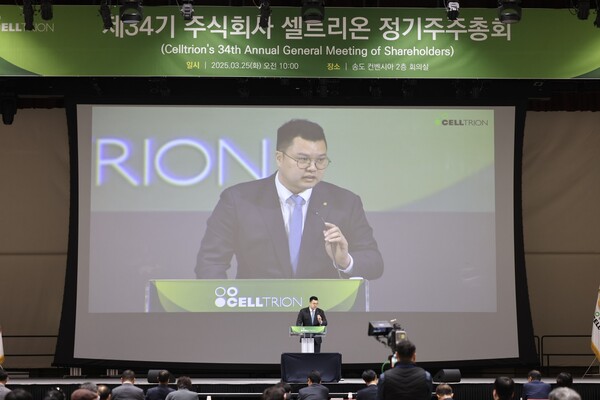Celltrion Chairman Seo Jung-jin will continue his involvement in company management for two more years after being reappointed as an executive director during the company’s 34th annual general shareholders’ meeting held at Songdo Convensia in Incheon on Tuesday.

Celltrion co-CEO and joint Chairperson of the Board of Directors Seo Jin-seok presides over the 34th annual general shareholders at Songdo Convensia in Incheon on Tuesday. (credit: Celltrion)
Seo had stepped down from the management frontline in 2021 but returned two years later as executive director and co-chairman of the board, citing the need for stronger leadership. His current term, which was set to expire this month, has now been extended through the latest shareholder vote. Seo did not attend the meeting due to health reasons.
The board justified its decision by noting Seo's outstanding leadership in product development, production, and sales strategies, adding that his continued presence would help solidify Celltrion’s position in the global pharmaceutical industry.
Meanwhile, a total of 4,693 shareholders attended the meeting, representing approximately 124 million shares, or 60.67 percent of Celltrion’s total voting shares.
Aside from Seo’s reappointment as an executive director, all four other agenda items, including the approval of the financial statements for the 34th fiscal year, a capital reserve reduction, an adjustment to the cap on director remuneration, and amendments to executive retirement payment regulations, passed.
**Celltrion CEO and President Seo Jin-seok reaffirms long-term growth strategy**
Speaking at the Tuesday meeting, Celltrion co-CEO and joint Chairperson of the Board of Directors Seo Jin-seok, the eldest son of Chairman Seo and head of the group’s business operations, expressed confidence that the company had moved beyond its post-merger transition period and was now entering a phase of tangible performance growth.
“The company would enhance corporate value by expanding global market share of key products, launching new offerings, and accelerating the development of novel drugs based on its accumulated technological expertise,” Seo said.
Seo revealed that four out of Celltrion’s ten investigational new drugs are entering clinical trials this year.
“Some of the company’s new drug candidates have already attracted attention from major global pharmaceutical companies,” Seo said.
The CEO also addressed shareholder concerns over the disappointing sales of Zymfentra, Celltrion’s autoimmune disease treatment that launched in the U.S. last year.
The company had projected annual sales of 500 to 600 billion won ($340 million-$408 million) for the drug, but actual figures came in at only 36.6 billion won last year.
One shareholder questioned the significant gap between the company’s forecast and its actual performance, and asked why shipment data had not been disclosed.
In response, Seo said shipment volumes have been steadily increasing, with month-over-month and year-over-year growth at times exceeding 50 percent or even doubling.
“Market share was not declining and attributed the sluggish performance to delays in market access and pricing negotiations unique to the U.S. market,” he said. “The U.S. system, especially around pharmacy benefit manager (PBM) registration and insurance contracting, involved more time-consuming procedures than expected.”
Seo stressed that the drug’s market potential remains strong, citing its success in Europe, where it holds over 50 percent market share.
The co-CEO also said that Celltrion plans to release detailed shipment data as soon as it becomes available and added that major product listings had now been completed, setting the stage for performance gains this year.
While acknowledging the challenges posed by global economic instability, Korean political changes, and U.S. tariff concerns, Seo remained optimistic.
“While the Korean stock market has remained sluggish overall, Celltrion is now positioned to realize tangible performance growth,” he said. “The company will continue working to boost corporate value through expanded global presence, new product launches, and the commercialization of innovative drug candidates.”